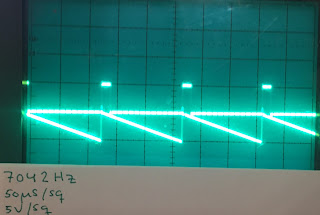All frequency tests seemed ok, and the charge current tracked the frequency almost perfectly, charging the saw core capacitor to 5V even if frequencies changed. Only for the lowest frequency I tried (16.35Hz) did the cap not fully charge. I successfully tried frequencies up to 7000Hz. At 14000Hz the charge current was once again too low, but this was expected as the DAC output cannot reach a high enough level with the current combination of cap and charge current converter resistor (100kOhm). I tried swapping the resistor for a 56k one and the saw voltage swing doubled as expected, so a little experimenting with various resistor values will probably fix this issue.
I have had some issues with the saw core op amp oscillating. Not sure what causes it (well, I suspect it is due to the capacitor in the feedback loop), but some brands seem more susceptible to this than others.
I've tried the TL072CP and TL062CP from Texas Instruments and they both oscillate. TL072BD and 4556D from JRC work fine. Maybe the B/C difference could explain it.
The DCO uses modern, easily available components, the reset transistor is a 2N3906. The DAC currently used is a MAX541, with an SPI speed of 8MHz. The 'production version' will probably use a MAX5216 as this is way cheaper.
I was not aware that I could get such a high speed, now I consider moving the DAC update into the interrupt routine. It will probably double the time spent in the routine, but even this would only reduce the max transfer speed from the master controller to the DCO to around 950kbps, meaning we could still update the DCO 50.000 times per second (or rather, transfer new pitch values, the DCO will only update at period reset positions).
Next up is adding and testing SPI control, then recalculating the lookup tables to be centred around Cs (a C should be at 32768 = virtual 0V). Then finally breadboarding the wave shaper circuitry and deciding on voltage control and how to center the waves around 0V.
I must also decide the p-p voltage output. 12V seems to be the Juno way, this is the highest "safe" voltage possible since the saw is generated between gnd and the negative power rail (-15V). I assume that keeping the voltage as high as possible up to the point where several waves are summed is a good idea, to keep noise to a minimum.
 |
| The charge current is a bit too low at the lowest frequency |
 |
| The dots above the peak of the saw wave is the reset pulse |
 |
| The reset pulse gets more and more visible as the frequency increases and we zoom in |
 |
| The charge current is too low above a certain frequency. This will be fixed. |







No comments:
Post a Comment